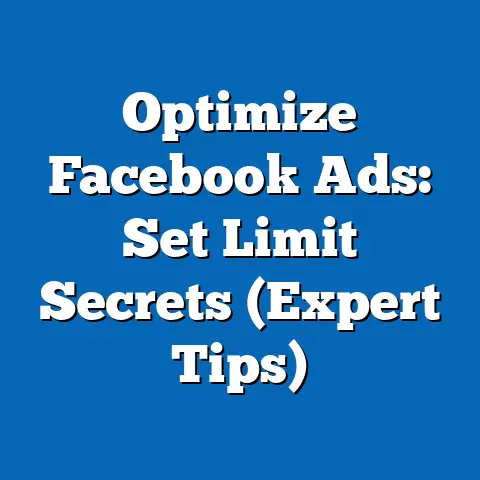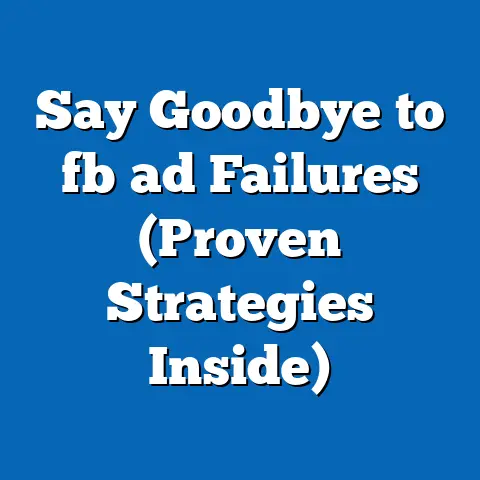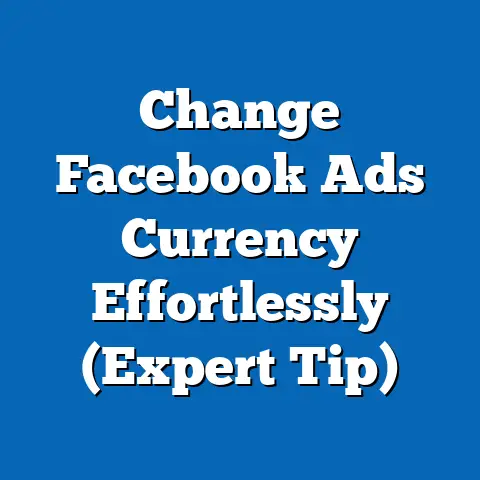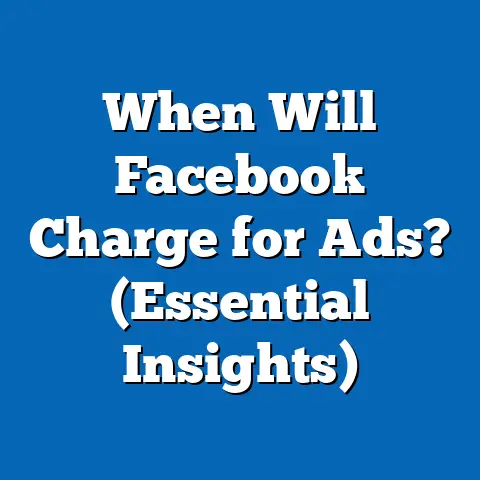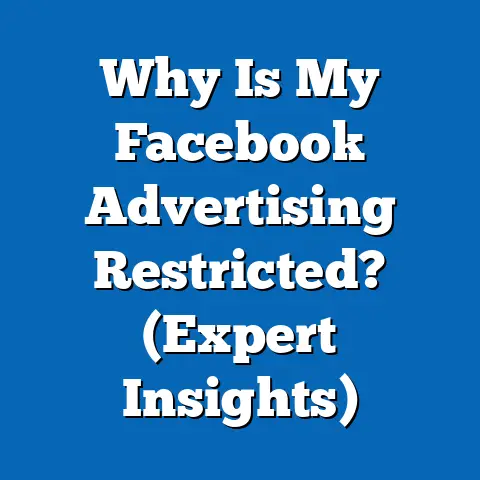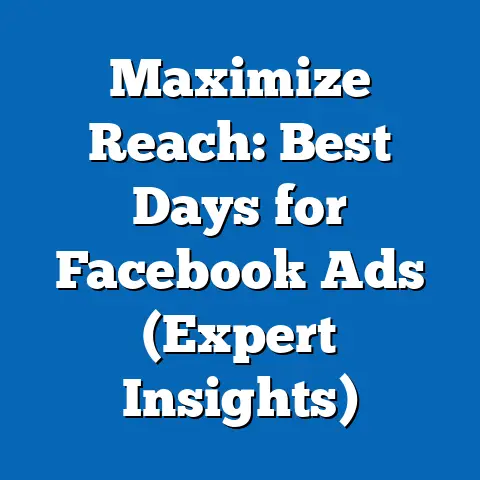Master Facebook Ad Saving Techniques (Expert Strategies)
Have you ever felt like you’re throwing money into a black hole with your Facebook ads? I know I have. I remember one campaign I ran for a local bakery. I was so excited, I had this mouthwatering photo of their signature chocolate cake, and I thought, “This is it! This is going to bring in hordes of customers!” I set my budget, launched the ad, and… crickets. I was spending money, but I wasn’t seeing the return. That’s when I realized I needed to get serious about mastering Facebook ad saving techniques.
Did you know that a significant portion of small business owners overspend on Facebook ads, often without even realizing it? It’s a common pitfall, and I’ve been there myself. But what if I told you there are expert strategies that can transform your ad budget from a leaky faucet to a powerful stream of leads and sales? What if you could turn your campaigns from mediocre to magnificent?
In this guide, I’m going to share the very strategies I’ve learned and implemented over years of managing Facebook ad campaigns for diverse businesses. We’re diving deep into the art of saving money on Facebook ads, not by cutting corners, but by being smarter, more strategic, and more data-driven. Get ready to unlock the secrets to maximizing your budget and achieving the ROI you deserve.
Understanding the Facebook Ads Ecosystem
Before we jump into the saving strategies, it’s crucial to understand how the Facebook ads ecosystem actually works. Think of it as an auction – a real-time bidding system where advertisers compete for the attention of Facebook users.
-
The Auction System: Each time a user visits Facebook or Instagram, an auction takes place. Facebook considers factors like your bid, ad quality, and estimated action rates to determine which ads to show. Higher bids don’t automatically guarantee a win; relevance and quality play a significant role.
-
Targeting is Key: Facebook’s targeting capabilities are incredibly powerful. You can target users based on demographics, interests, behaviors, and even custom audiences based on your existing customer data. The more precise your targeting, the more likely you are to reach the right people, reducing wasted ad spend. I’ve seen campaigns where simply refining the target audience cut costs by over 30% while simultaneously boosting conversions.
-
Bidding Strategies: You have control over how you bid in the auction. Facebook offers various bidding strategies, including lowest cost, cost per result goal, and value-based bidding. Choosing the right strategy depends on your campaign objectives and the data you have available.
-
Return on Ad Spend (ROAS): This is your holy grail. ROAS measures the revenue you generate for every dollar you spend on ads. A higher ROAS indicates a more efficient campaign. Consistently tracking and analyzing your ROAS is essential for identifying areas for improvement and optimizing your ad spend. I always tell my clients, “If you’re not tracking your ROAS, you’re flying blind.”
The Auction System: Each time a user visits Facebook or Instagram, an auction takes place. Facebook considers factors like your bid, ad quality, and estimated action rates to determine which ads to show. Higher bids don’t automatically guarantee a win; relevance and quality play a significant role.
Targeting is Key: Facebook’s targeting capabilities are incredibly powerful. You can target users based on demographics, interests, behaviors, and even custom audiences based on your existing customer data. The more precise your targeting, the more likely you are to reach the right people, reducing wasted ad spend. I’ve seen campaigns where simply refining the target audience cut costs by over 30% while simultaneously boosting conversions.
Bidding Strategies: You have control over how you bid in the auction. Facebook offers various bidding strategies, including lowest cost, cost per result goal, and value-based bidding. Choosing the right strategy depends on your campaign objectives and the data you have available.
Return on Ad Spend (ROAS): This is your holy grail. ROAS measures the revenue you generate for every dollar you spend on ads. A higher ROAS indicates a more efficient campaign. Consistently tracking and analyzing your ROAS is essential for identifying areas for improvement and optimizing your ad spend. I always tell my clients, “If you’re not tracking your ROAS, you’re flying blind.”
Takeaway: Understanding the nuances of the Facebook ads ecosystem is the foundation for effective ad saving. Don’t just throw money at the platform; learn how it works and make informed decisions.
The Cost of Ignoring Ad Efficiency
Ignoring ad efficiency is like leaving a tap running – it slowly drains your resources. It’s a common mistake, especially for businesses new to Facebook advertising. Let’s look at some real-world examples:
-
The Case of the Clothing Boutique: A local clothing boutique launched a Facebook ad campaign targeting everyone in their city aged 18-65. They spent a significant amount of money but saw very few sales. Why? Their targeting was too broad. They were showing ads to people who had no interest in their clothing style or price point. A more targeted approach, focusing on women aged 25-45 interested in fashion and online shopping, would have been far more effective.
-
The Restaurant with the Blurry Photo: A restaurant ran an ad campaign with a low-quality, blurry photo of their food. The ad received very little engagement and generated almost no reservations. The problem? Their ad creative was unappealing. People are visually driven, especially on platforms like Facebook and Instagram. Investing in professional photos or videos can significantly improve ad performance.
-
The E-commerce Store with the Broken Link: An e-commerce store ran an ad campaign promoting a specific product. However, the link in the ad led to a broken page on their website. This resulted in a high click-through rate but zero sales. A simple mistake, but a costly one! Always double-check your links!
The Case of the Clothing Boutique: A local clothing boutique launched a Facebook ad campaign targeting everyone in their city aged 18-65. They spent a significant amount of money but saw very few sales. Why? Their targeting was too broad. They were showing ads to people who had no interest in their clothing style or price point. A more targeted approach, focusing on women aged 25-45 interested in fashion and online shopping, would have been far more effective.
The Restaurant with the Blurry Photo: A restaurant ran an ad campaign with a low-quality, blurry photo of their food. The ad received very little engagement and generated almost no reservations. The problem? Their ad creative was unappealing. People are visually driven, especially on platforms like Facebook and Instagram. Investing in professional photos or videos can significantly improve ad performance.
The E-commerce Store with the Broken Link: An e-commerce store ran an ad campaign promoting a specific product. However, the link in the ad led to a broken page on their website. This resulted in a high click-through rate but zero sales. A simple mistake, but a costly one! Always double-check your links!
These examples highlight the real financial impact of poor ad efficiency. It’s not just about wasting money; it’s about missing opportunities to grow your business. I once worked with a client who was convinced Facebook ads didn’t work for them. They had tried a few campaigns in the past with little success and had given up. After a thorough audit of their previous campaigns, I discovered a host of issues, including poor targeting, irrelevant ad creatives, and a lack of tracking. By addressing these inefficiencies, we were able to turn their Facebook ads into a profitable marketing channel.
Takeaway: Don’t let your ad budget go to waste. Pay attention to the details, learn from your mistakes, and continuously optimize your campaigns for maximum efficiency.
Expert Strategy #1: Laser-Focused Targeting
Targeting is the cornerstone of successful Facebook advertising. It’s about showing your ads to the people who are most likely to be interested in your products or services. Facebook offers a wide range of targeting options, allowing you to get incredibly specific.
-
Custom Audiences: This is where the magic happens. Custom Audiences allow you to target people who have already interacted with your business. You can upload a list of your existing customers, target website visitors, or engage with people who have interacted with your Facebook page or Instagram profile. I’ve seen custom audiences consistently outperform other targeting options, as these users are already familiar with your brand.
-
Lookalike Audiences: Take your custom audiences to the next level with Lookalike Audiences. Facebook will analyze your custom audience and find other users who share similar characteristics. This is a fantastic way to expand your reach and find new customers who are likely to be interested in your offerings. The key is to start with a high-quality source audience – the better your custom audience, the better your lookalike audience will be.
-
Interest-Based Targeting: Target users based on their interests, hobbies, and activities. Facebook gathers this information from user profiles, pages they like, and content they engage with. This is a great way to reach a broad audience with specific interests related to your products or services. However, be careful not to be too broad. Refine your targeting by layering multiple interests or combining interest-based targeting with demographic filters.
-
Demographic Targeting: Target users based on their age, gender, location, education, and other demographic factors. This is a fundamental targeting option that can be used to narrow down your audience and ensure you’re reaching the right people.
-
Facebook Audience Insights: This tool is a goldmine of information. It allows you to analyze the demographics, interests, and behaviors of your target audience. Use it to refine your targeting and gain a deeper understanding of your ideal customer.
Custom Audiences: This is where the magic happens. Custom Audiences allow you to target people who have already interacted with your business. You can upload a list of your existing customers, target website visitors, or engage with people who have interacted with your Facebook page or Instagram profile. I’ve seen custom audiences consistently outperform other targeting options, as these users are already familiar with your brand.
Lookalike Audiences: Take your custom audiences to the next level with Lookalike Audiences. Facebook will analyze your custom audience and find other users who share similar characteristics. This is a fantastic way to expand your reach and find new customers who are likely to be interested in your offerings. The key is to start with a high-quality source audience – the better your custom audience, the better your lookalike audience will be.
Interest-Based Targeting: Target users based on their interests, hobbies, and activities. Facebook gathers this information from user profiles, pages they like, and content they engage with. This is a great way to reach a broad audience with specific interests related to your products or services. However, be careful not to be too broad. Refine your targeting by layering multiple interests or combining interest-based targeting with demographic filters.
Demographic Targeting: Target users based on their age, gender, location, education, and other demographic factors. This is a fundamental targeting option that can be used to narrow down your audience and ensure you’re reaching the right people.
Facebook Audience Insights: This tool is a goldmine of information. It allows you to analyze the demographics, interests, and behaviors of your target audience. Use it to refine your targeting and gain a deeper understanding of your ideal customer.
I remember working with a client who sold organic baby clothes. Initially, they were targeting parents in general, but their ads weren’t performing well. By using Facebook Audience Insights, we discovered that their ideal customer was actually eco-conscious moms aged 25-35 who were interested in organic food, sustainable living, and natural parenting. By refining their targeting to focus on this specific segment, we saw a significant improvement in their ad performance.
Takeaway: Don’t settle for broad targeting. Take the time to understand your ideal customer and use Facebook’s powerful targeting options to reach them with precision.
Expert Strategy #2: A/B Testing for the Win
A/B testing, also known as split testing, is the process of comparing two versions of an ad to see which one performs better. It’s a crucial strategy for optimizing your ad creatives, headlines, and calls to action.
-
Why A/B Testing Matters: A/B testing allows you to make data-driven decisions about your ads. Instead of relying on guesswork, you can test different elements and see what resonates best with your audience. This can lead to significant improvements in your ad performance and save you money in the long run.
-
What to Test: The possibilities are endless! You can test different headlines, images, videos, calls to action, ad copy, and even targeting options. The key is to test one element at a time so you can isolate the impact of each change.
-
How to Set Up an A/B Test: Facebook makes it easy to set up A/B tests within the Ads Manager. Simply create two versions of your ad, each with a different element that you want to test. Facebook will then split your audience and show each version to a different group of people.
-
Analyzing Your Results: After running your A/B test for a sufficient period of time (typically a few days or a week), analyze the results to see which version performed better. Look at metrics like click-through rate (CTR), conversion rate, and cost per conversion to determine the winner.
-
Continuous Testing: A/B testing is not a one-time activity. It’s an ongoing process of optimization. Continuously test different elements of your ads to identify winning combinations and improve your ad performance over time.
Why A/B Testing Matters: A/B testing allows you to make data-driven decisions about your ads. Instead of relying on guesswork, you can test different elements and see what resonates best with your audience. This can lead to significant improvements in your ad performance and save you money in the long run.
What to Test: The possibilities are endless! You can test different headlines, images, videos, calls to action, ad copy, and even targeting options. The key is to test one element at a time so you can isolate the impact of each change.
How to Set Up an A/B Test: Facebook makes it easy to set up A/B tests within the Ads Manager. Simply create two versions of your ad, each with a different element that you want to test. Facebook will then split your audience and show each version to a different group of people.
Analyzing Your Results: After running your A/B test for a sufficient period of time (typically a few days or a week), analyze the results to see which version performed better. Look at metrics like click-through rate (CTR), conversion rate, and cost per conversion to determine the winner.
Continuous Testing: A/B testing is not a one-time activity. It’s an ongoing process of optimization. Continuously test different elements of your ads to identify winning combinations and improve your ad performance over time.
I once worked with a client who was running a Facebook ad campaign promoting a free e-book. They were struggling to generate leads, so we decided to A/B test different headlines. We tested two headlines: “Download Your Free E-book Now” and “Unlock the Secrets to [Your Industry] Success.” The second headline, which focused on the value proposition of the e-book, significantly outperformed the first, resulting in a 50% increase in lead generation.
Takeaway: A/B testing is your secret weapon for optimizing your Facebook ads. Embrace it, experiment with different elements, and let the data guide your decisions.
Expert Strategy #3: Budget Management Techniques
Effective budget management is essential for maximizing your ROI on Facebook ads. It’s not just about setting a budget; it’s about strategically allocating your funds and adjusting your spending based on performance.
-
Daily vs. Lifetime Budgets: You can choose between setting a daily budget or a lifetime budget for your ad campaign. A daily budget allows you to spend a consistent amount of money each day, while a lifetime budget allows you to spend a specific amount of money over the entire duration of your campaign. The best choice depends on your campaign objectives and your level of involvement in managing your ads. If you want more control and flexibility, a daily budget is often the better option.
-
Budget Optimization: Facebook offers budget optimization features that automatically adjust your budget based on performance. Campaign Budget Optimization (CBO) allows you to set a budget at the campaign level and let Facebook distribute it across your ad sets based on which ones are performing best. Ad Set Budget Optimization (ABO) allows you to set a budget for each individual ad set.
-
Real-Time Adjustments: Don’t set it and forget it! Monitor your ad performance closely and make adjustments to your budget in real-time. If you see that certain ad sets are performing well, increase their budget to maximize your results. If you see that other ad sets are underperforming, decrease their budget or pause them altogether.
-
Clear Goals and KPIs: Before launching your ad campaign, set clear goals and key performance indicators (KPIs). What do you want to achieve with your ads? Do you want to generate leads, drive sales, or increase brand awareness? Once you have defined your goals, you can track your progress and make informed decisions about your budget allocation.
Daily vs. Lifetime Budgets: You can choose between setting a daily budget or a lifetime budget for your ad campaign. A daily budget allows you to spend a consistent amount of money each day, while a lifetime budget allows you to spend a specific amount of money over the entire duration of your campaign. The best choice depends on your campaign objectives and your level of involvement in managing your ads. If you want more control and flexibility, a daily budget is often the better option.
Budget Optimization: Facebook offers budget optimization features that automatically adjust your budget based on performance. Campaign Budget Optimization (CBO) allows you to set a budget at the campaign level and let Facebook distribute it across your ad sets based on which ones are performing best. Ad Set Budget Optimization (ABO) allows you to set a budget for each individual ad set.
Real-Time Adjustments: Don’t set it and forget it! Monitor your ad performance closely and make adjustments to your budget in real-time. If you see that certain ad sets are performing well, increase their budget to maximize your results. If you see that other ad sets are underperforming, decrease their budget or pause them altogether.
Clear Goals and KPIs: Before launching your ad campaign, set clear goals and key performance indicators (KPIs). What do you want to achieve with your ads? Do you want to generate leads, drive sales, or increase brand awareness? Once you have defined your goals, you can track your progress and make informed decisions about your budget allocation.
I remember working with a client who was running a Facebook ad campaign to promote a new product launch. They had set a lifetime budget for the campaign and were not actively monitoring their performance. After a few days, I noticed that one of their ad sets was significantly underperforming. By adjusting their budget to allocate more funds to the better-performing ad sets, we were able to increase their overall ROI by 20%.
Takeaway: Budget management is an ongoing process of monitoring, analyzing, and adjusting. Be proactive, stay informed, and make data-driven decisions to maximize your ad spend.
Expert Strategy #4: Retargeting for Cost-Effective Conversions
Retargeting is the process of showing ads to people who have already interacted with your business, such as website visitors, email subscribers, or social media followers. It’s one of the most cost-effective advertising strategies available.
-
Why Retargeting Works: Retargeting works because it targets people who are already familiar with your brand. They have shown some level of interest in your products or services, making them more likely to convert.
-
Types of Retargeting: There are several different types of retargeting you can use on Facebook, including:
- Website Retargeting: Target people who have visited your website.
- Email List Retargeting: Target people on your email list.
- Engagement Retargeting: Target people who have interacted with your Facebook page or Instagram profile.
- Video Retargeting: Target people who have watched your videos on Facebook or Instagram.
-
Creating Effective Retargeting Campaigns: To create effective retargeting campaigns, you need to:
- Segment Your Audience: Don’t treat all retargeting audiences the same. Segment your audience based on their behavior and tailor your ads accordingly. For example, you might show different ads to people who abandoned their shopping cart than to people who simply visited your website.
- Use Compelling Ad Creatives: Your ad creatives should be relevant to the audience you are targeting. Use images and videos that are visually appealing and that highlight the benefits of your products or services.
- Offer Incentives: Encourage conversions by offering incentives, such as discounts, free shipping, or exclusive deals.
Why Retargeting Works: Retargeting works because it targets people who are already familiar with your brand. They have shown some level of interest in your products or services, making them more likely to convert.
Types of Retargeting: There are several different types of retargeting you can use on Facebook, including:
- Website Retargeting: Target people who have visited your website.
- Email List Retargeting: Target people on your email list.
- Engagement Retargeting: Target people who have interacted with your Facebook page or Instagram profile.
- Video Retargeting: Target people who have watched your videos on Facebook or Instagram.
Creating Effective Retargeting Campaigns: To create effective retargeting campaigns, you need to:
- Segment Your Audience: Don’t treat all retargeting audiences the same. Segment your audience based on their behavior and tailor your ads accordingly. For example, you might show different ads to people who abandoned their shopping cart than to people who simply visited your website.
- Use Compelling Ad Creatives: Your ad creatives should be relevant to the audience you are targeting. Use images and videos that are visually appealing and that highlight the benefits of your products or services.
- Offer Incentives: Encourage conversions by offering incentives, such as discounts, free shipping, or exclusive deals.
I once worked with a client who was running a retargeting campaign for an e-commerce store. They were targeting people who had abandoned their shopping cart. By offering a 10% discount on their purchase, they were able to recover a significant number of abandoned carts and increase their sales by 15%.
Takeaway: Retargeting is a powerful tool for driving conversions and maximizing your ROI on Facebook ads. Use it wisely and you’ll see a significant improvement in your results.
Conclusion
Mastering Facebook ad saving techniques is not just about cutting costs; it’s about optimizing your ad spend to achieve the best possible results. By understanding the Facebook ads ecosystem, avoiding common pitfalls, and implementing expert strategies like laser-focused targeting, A/B testing, budget management, and retargeting, you can transform your ad campaigns from mediocre to magnificent.
I encourage you to implement the strategies discussed in this guide and to view your ad spend as an investment in your business. With the right approach, Facebook ads can be a powerful tool for driving growth and achieving your marketing goals. Don’t be afraid to experiment, learn from your mistakes, and continuously optimize your campaigns for maximum efficiency.
Now go out there and turn your ad budget into gold! The potential for growth and success is within your reach. Take action today and start seeing the results you deserve.

